Mammals & Birds
Canyon Country Nature GuideMammals
Many species of mammal are known to live in canyon country. Some, like desert cottontails, kangaroo rats and mule deer, are common and are often seen. However, many desert animals are inactive during daylight hours or are wary of humans, so sightings can be truly special events. Tracks and scat are the most common signs of an animal’s presence. Here are a few of the mammals that you may see in canyon country.
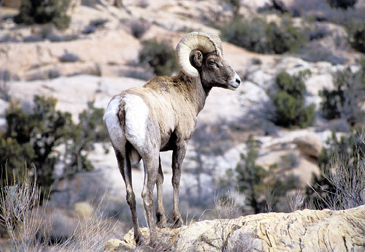
Desert Bighorn Sheep
(Ovis canadensis)
Bighorn sheep have the ability to climb very rugged and even vertical terrain and use their climbing skills to escape predators. Rams (males) have large curved horns that can weigh up to 30 lbs. (13.6 kg), while ewes (females) have short, slightly curved horns. Both sexes have grey-brown hair and a white rump and belly. Bighorn sheep need access to water in this arid region, and their diet consists of mostly shrubs and grasses.
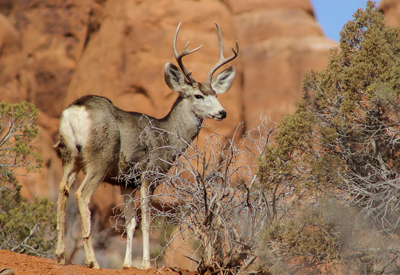
Mule Deer
(Odocoileus hemionus)
Mule deer are most commonly seen at dawn and dusk when they are foraging for food and heading towards a water source. Mule deer rarely travel far from water and vegetation sources and will bed down in protected areas during the day. Mule deer feed on woody vegetation and forbs. The “rut” or mating season begins in the fall and the gestation period for does is about 200 days. Fawns are born in the spring and stay with their mothers during the summer

Coyote
(Canis latrans)
The coyote is a medium-size canine with a bushy tail, pointed ears, and a long nose. Coyotes are known for their piercing howl but they also bark, growl, yip and whine. Coyotes are very resourceful and can easily adapt to changing conditions. They mostly eat rabbits and rodents but will also eat domesticated animals, deer, sheep, and insects.
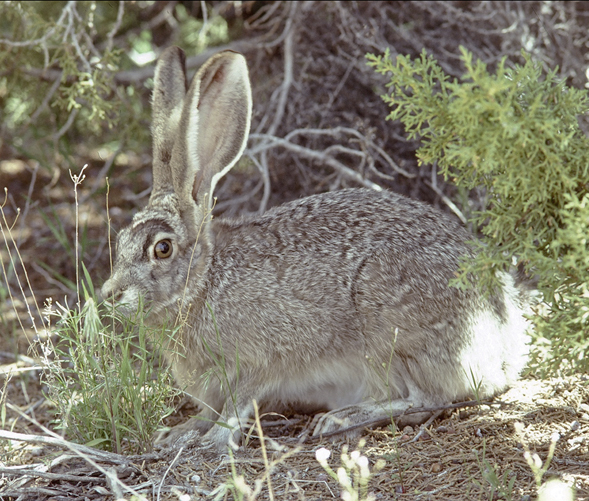
Black-Tailed Jackrabbit
(Lepus californicus)
Jackrabbits spend most of their day under shrubs. They like to feed at dawn and dusk. Jackrabbits obtain most of their water from their food. They cope with high temperatures by dissipating heat through their large ears. Open areas provide ideal escape terrain. Jacks can sprint up to 35 miles per hour (56 km/h) when being chases by a predator. Predators include – large snakes, coyotes, raptors and foxes.
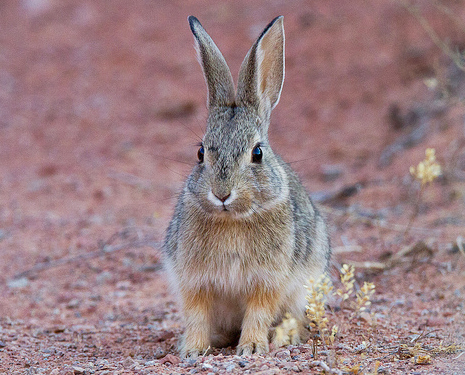
Desert Cottontail
(Sylvilagus audubonii)
This desert rabbit is widespread throughout the southwest at elevations below 5000 ft. (1524 m). They spend their days in burrows or under brush. They will often run if approached. Desert cottontail females may bear several litters of young each year. Their average life span is about one year because of their many predators. Watch for these rabbits at dawn and dusk actively eating plants.
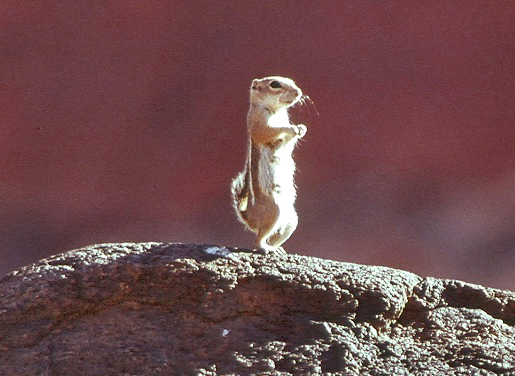
White-Tailed Antelope Ground Squirrel
(Ammospermophilus leucurus)
This is a unique animal because it is diurnal, which means it is most active during daytime hours. In the heat they cool themselves by rubbing saliva on their faces. They spend their nights and other periods of inactivity in underground burrows. The White-tailed Antelope squirrel feeds on seeds, fruit, plants, insects, lizards and carrion. Sometimes when startled they produce a birdlike call. In the spring females give birth to one or two litters with an average of five squirrels in each.
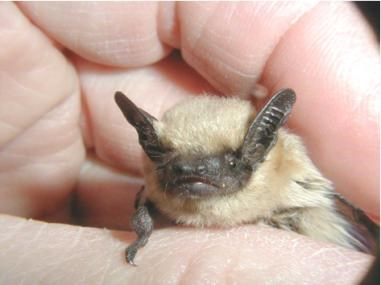
Canyon Bat
(Parastrellus hesperus)
Although this bat is nocturnal, it may also be seen occasionally during the day. The canyon bat is mostly seen around sunset actively consuming numerous insects such as moths and mosquitoes. Many bats are often seen foraging over water and in rocky canyons. They have a slow, fluttery flight.
Birds
Birds are the most visible animals in canyon country. While the area is not considered a bird watching hot spot, over 250 species have been sited, including seasonal and year-round residents as well as migrants. In the desert, animal life tends to concentrate around riparian areas because of the abundance of food, water and shelter. Riparian corridors like Mill Creek, Pack Creek, Courthouse Wash and the Colorado River make this diversity possible.
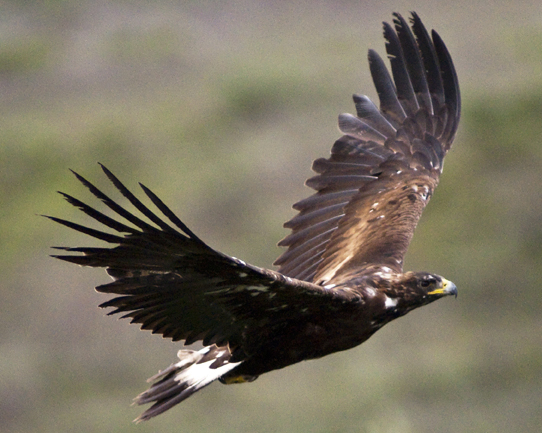
Golden Eagle
(Aquila chrysetos)
The Golden Eagle is a large brown bird with a golden head and a wing span of about 6 ft (1.8 m) or more. This member of the hawk family is one of the most impressive soaring birds seen in this park. You may see it perched on ledges looking for their prey, reptiles, large rodents, small mammals or even coyotes. Golden eagles mate for life returning to the same nesting area annually.
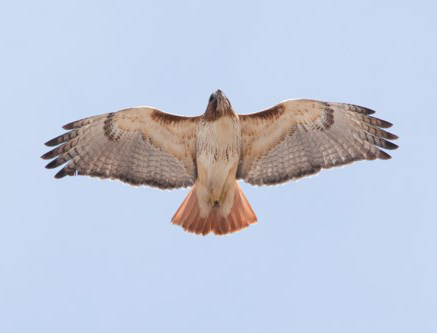
Red-Tailed Hawk
(Buteo jamaicensis)
Red-tailed hawks are the most common large bird of prey you will see. They vary in color, with a dark back, white under parts, reddish top of the tail and dark patches on the forward side of the underwing. These hawks have broad rounded wings. They are often seen perching, looking for prey such as grasshoppers, rodents, rabbits, and even rattlesnakes and gopher snakes.

Common Raven
(Corvus corax)
Ravens are very commonly seen in the park. They are large black birds with large black beaks. Ravens are about 25 inches (63.5 cm) in length. Males are larger than the females. The raven displays abilities to play and problem-solve rare among animals. This member of the crow family is also very vocal, using a variety of sounds for communication. Clever ravens have figured out how to open zippers and velcro closures in search of visitors’ food. Please do not feed them or leave food unattended in campsites, backpacks, or cars with open windows.
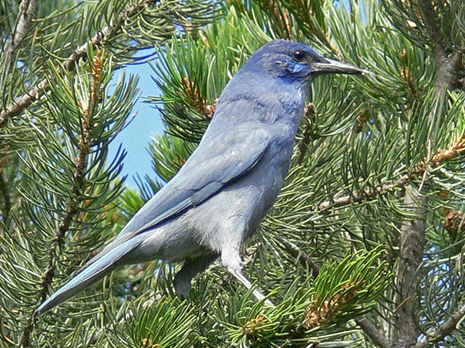
Pinyon Jay
(Gymnorhinus cyanocephalus)
Medium in size, these birds are about 10-12 inches (16-19 cm) in length. They are a dull light blue and gray in color. Pinyon jays feed almost exclusively on pinyon pine nuts. During the fall hundreds of Pinyon jays can be seen on pinyon trees collecting, eating, and caching pinyon nuts.
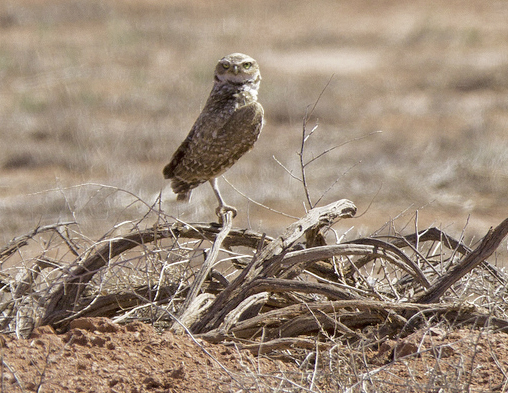
Burrowing Owl
(Athene cunecularia)
This small owl, only 9 inches (23 cm) in length, lives in the open desert and grasslands. They live underground in prairie dog burrows and sometimes are seen during daytime hours. They feed primarily at night and prefer kangaroo rats, lizards, grasshoppers and crickets. Burrowing owls have very long legs, distinguishing it from other owl species.

Canyon Wren
(Catherpes mexicanus)
The Canyon wren is a commonly seen small bird about 5 to 6 inches (12 to 15 cm) in length. This bird lives high on cliff faces in crevices in the rock. The canyon wren is a mottled rusty color with a white bibbed chest and a dark chestnut-brown underbelly. They are very active and have long thin bills that help them extract insects from crevices in the rock. The distinctive call of the canyon wren is a cascade of musical whistles.
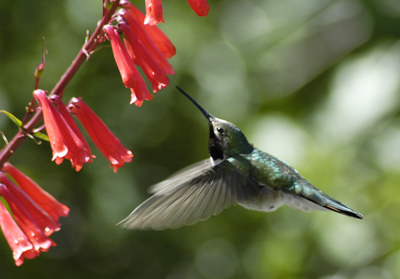
Black-Chinned Hummingbird
(Archilochus alexandri)
This is a tiny bird measures only 3.5 inches (8.8 cm) in length. The male is distinguished by its black chin bordered by a purple collar. They are green with a white underbelly. Their purple lower throat is visible only in good light. The female’s chin is white. Hummers feed on flowers with sweet nectar and also eat insects and spiders. Hummingbirds can fly forwards, backwards, sideways and can also hover and take off vertically. This hummingbird beats its wings at an incredible 50 times per second.
